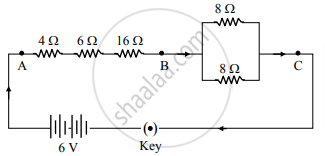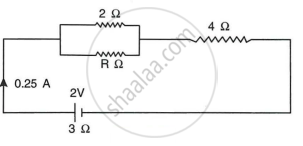Advertisements
Advertisements
प्रश्न
Study the following circuit:

On the basis of this circuit, answer the following questions:
i. Find the value of total resistance between the points A and B.
ii. Find the resistance between the points B and C.
iii. Calculate the current drawn from the battery, when the key is closed
OR
iii. In the above circuit, the 16Ω resistor or the parallel combination of two resistors of 8 Ω, which one of the two will have more potential difference across its two ends? Justify your answer.
उत्तर
i. To find the total resistance between points A and B, we simply add up the resistances in series:
RAB = R4Ω + R6Ω + R16Ω = 4Ω + 6Ω + 16Ω = 26Ω
ii. The resistance between points B and C is a bit more complex because we have two resistances in parallel. We use the formula for resistances in parallel:
`1/R_(BC)=1/R_(8Ω,upper)+1/R_(8Ω,lower)`
`1/R_(BC)=1/(8Ω)+1/(8Ω)= 1/(4Ω)`
`R_(BC) = 4Ω`
iii. To calculate the current drawn from the battery when the key is closed, we need to find the total resistance in the circuit. The total resistance will be the sum of the resistance between A and B and the equivalent resistance between B and C which we found to be
RAB + RBC = 26Ω + 4Ω = 30Ω
Now, using Ohm's Law (V=IR), where V is the voltage of the battery, I is the current, and R is the total resistance, we can find the current:
`I = V/R = (6V)/(30Ω) = 0.2 A`
So, the current drawn from the battery is 0.2 A (or 200 mA).
OR
iii. The potential difference across a resistor in a circuit is given by Ohm's Law, which states:
V = I.R
where V is the potential difference, I is the current, and R is the resistance.
In the given circuit, the 16Ω resistor is in series with two other resistors (4Ω and 6Ω), and the combination of two 8Ω resistors is in parallel. The total resistance in series (4Ω + 6Ω + 16Ω = 26Ω) is greater than the effective resistance of the parallel combination of two 8Ω resistors which is 4Ω, since resistors in parallel have an effective resistance Rparallel given by
`1/R_("parallel")=1/R_1+1/R_2`
Therefore, the series combination (including the 16Ω resistor) has more resistance than the parallel combination, which means it will have more potential difference across it. Since the same current flows through the series resistors, the potential difference across the 16Ω resistor will be the largest among the individual resistors because it has the highest resistance.
So, the 16Ω resistor will have more potential difference across its ends than the parallel combination of two 8Ω resistors.
APPEARS IN
संबंधित प्रश्न
Several electric bulbs designed to be used on a 220 V electric supply line are rated 10 W. How many lamps can be connected in parallel with each other across the two wires of 220 V line if the maximum allowable current is 5 A?
Show how would you join three resistors, each of resistance 9 Ω so that the equivalent resistance of the combination is
1) 13.5
2) 6 Ω
Two resistors, with resistance 5 Ω and 10 Ω respectively are to be connected to a battery of emf 6 V so as to obtain:
(i) minimum current flowing
(ii) maximum current flowing
(a) How will you connect the resistances in each case?
(b) Calculate the strength of the total current in the circuit in the two cases.
A 4 Ω coil and a 2 Ω coil are connected in parallel. What is their combined resistance? A total current of 3 A passes through the coils. What current passes through the 2 Ω coil?
A wire of resistance R1 is cut into five equal pieces. These five pieces of wire are then connected in parallel. If the resultant resistance of this combination be R2, then the ratio `R_1/R_2` is:
(a) `1/25`
(b)1/5
(c)5
(c)25
A combination consists of three resistors in series. Four similar sets are connected in parallel. If the resistance of each resistor is 2 ohm, find the resistance of the combination.
Show how would you connect three resistors, each of resistance 6 O so that
the combination has a resistance of(a) 9 Ω (b) 4 .Ω
The circuit diagram Fig shows three resistors 2 Ω, 4 Ω and R Ω connected to a battery of e.m.f. 2 V and internal resistance 3 Ω. If main current of 0.25 A flows through the circuit, find:

- the p.d. across the 4 Ω resistor,
- the p.d. across the internal resistance of the cell,
- the p.d. across the R Ω or 2 Ω resistors
- the value of R.
A piece of wire having a resistance R is cut into five equal parts.
- How will the resistance of each part of the wire change compared with the original resistance?
- If the five parts of the wire are placed in parallel, how will the resistance of the combination change?
- What will be ratio of the effective resistance in series connection to that of the parallel connection?
Three resistors of 6Ω, 4Ω and 4Ω are connected together so that the total resistance is 8Ω. Draw a diagram to show this arrangement and give reason to justify your answer.
